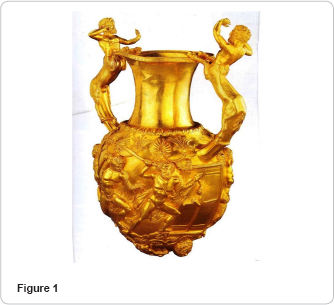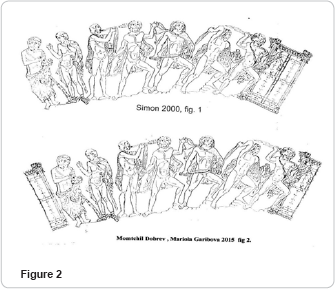The Momtchil Dobrev-Halachev's and Mariola Garibova's Interpretation of the Scene of Amphora-Rython from the Panagjuriste Gold Treasure in Bulgaria
Momtchil DH*, Mariola Garibova and Penka Todorova
Department of Archaelogy, Scientific Research Institute Dobrev & Halachev, Bulgaria
Submission: May 03, 2017 Published: June 08, 2017
*Corresponding author: Momtchil DH, Department of Archaelogy, Scientific Research Institute Dobrev & Halachev, 1404 Sofia, j.k.G.Delchev, P.O. Box 101, Bl.244, E,80, Europa, Bulgaria, Tel: 0897310747, 0878103031; Email: lordprmdobrev@gmail.com
How to cite this article: Momtchil D, Mariola G &&38; Penka T . The Momtchil Dobrev-Halachev's and Mariola Garibova's Interpretation of the Scene of Amphora-Rython from the Panagjuriste Gold Treasure in Bulgaria. Glob J Arch & Anthropol. 2017; 1(3): 555564. DOI: 10.19080/GJAA.2017.01.555564
Abstract
In the paper is described the different interpretation of the amphora-rython from the Panagjuriste Gold Treasure in Bulgaria. This interpretation is different to all the made this before. The different interpretation is made by Lord Prof. Res. /Prof. PhD Momtchil Dobrev- Halachev's and the Lady Prof. PhD Mariola Garibova
Keywords: Gold treasure; Amphora-rython; Panagjuriste
Introduction
Panagjurishte Gold treasure was found on 8 December 1949 in the vicinity of the town of Panagyurishte in Bulgaria by three brothers. It consists of nine vessels nine containers are made of pure gold and have weight of 6.164kg. They have an amphora- rhyton , three jugs-rhytons female heads, three rhytons shaped animal heads with protome of a goat and a phial [1-2].
Amphora rhyton is actually the largest, most ornate and heaviest against other vessels. Bottom is rounded and ovoid is highly smooth neck that smooth transition, but issued outside estuarine edge and two handles shaped like centaurs. On the bottom are presented child / small Hermes / which is struggling with two snakes and strong with curly hair and beard, S Brashlyanov crown of the head. Between the figures are two nigger heads with openings at the mouths. In these holes was to expire wine. This makes the court intended for drinking by two people.This corresponds to the information of such drinking at a union between two people or twinning between two people.We believe that it is a union of two people in mind our interpretation [3-4].
Compared to the other to the walls, images. The bottom modeled fairly clumsy. The main frieze is the central scene is limited from above by a wreath of lotus flowers is palmette.The scene is divided into two two-winged "wooden door, rigid with the help of nails with round decorative heads Beside door is channeled delineated by columns with Ionic capitals and forest Bars and threshold are decorated with pearls. Between the two wings of the door half-opened is fet of the figure of the bald bearded man. To the left of the door toward him run five men behind one another. They are naked, draped their cloaks are fluttering from wind or due to rapid dance. NVsechki, except for the third, are bearded and visibly vazstarstni. The first four brandish swords fifth playing the trumpet. All are tense bodies and strongly emphasized and preivelicheni meters On the other side of the door "peace reigns". Leaning on knotty sticks there quietly talking young man with only stubble, half-naked, wearing high boots and an old man, also scantily clad and barefoot. With his right hand he holds shows in the left obscure subject. The tranquility of the two highly contrasted voltage in the other five. The little man in the middle balance curious scenes and, Auger Biu slightly frightened expression and experience body and hands to keep ajar slightly bent right-side door in an effort to izmeze from there to remain in place or be quick to hide. Toizglezhda will prove that treats their behavior with the goal of which is called the key to the interpretation of the image also the main frieze [5-6].
So far expressed quite contradictory interpretations of scenes.The first researcher treasure Dimitar Tsonchev scenes illustrate the myth of the discovery of Achilles among the daughters of King lycomedes Island Skires.Another interpretation was proposed by German scientist Hoffman, who sees the walls of the amphora duties sons of Heracles. The two men assured he defined as Heracles and Yoraos who foretell the future by liver [7-8].
On the other hand Zh.Ru accepted definition of obscure subject like liver, but interpreted the scene as murder Neoptolev in the sanctuary of Apollo at Delphi. According to G. Roux stage a bit, not military.Another interpretation suggests Del Medico. He believes the treasure belonged to Alexander the Macedonian. In the images he sees moments of the exploits of captain. The old inter according to him Amen, who corrupts a gold ingot Persian fugitive. The aim is to obtain from him information about the army of Persians. The second scene Del Medico explained as "takeover of the Persian door." Beardless leader he sees himself let Aleksandar Makedonski. On the other hand prof. Griffith sees the comic stage musical by defines a scene in which the company sees a drunk men who attacked the house but a girl. The old man, according to Del Medico Amen. He believes that the old man bribed with gold ingot Persian fugitive to get information from him about the army of Persians [9-10].
Another scene Del Medico explained as "takeover of the Persian door" and the beardless soldier sees himself notes Mr. Alexander Comic scene sees prof. Griffin, who said the men drink company that attacked house of a girl. Reason for this gives him the men's clothing, which no suitable for combat.
Our opinion is that in itself poses the wars and how hold swords indicates that they are drunk themselves aspire faces and postures prove quite the opposite. The player actually played for assembly and protection.

Most supporters have proposed by Simon E (Figure 1) and defended by professor Ivan Marazov thesis that the scene represents a part of the myth of the "Seven against Thebes" - heroes stormed seven city gates in the hope that after the victory will be returned by Argonne king Adrastus as rulers of their own cities.
Our opinion is that six naked men cannot storm the city gates. The fact that naked does not allow it. There is no logic in this.
Another interpretation, first proposed by Kamen Kolev developed by Georgi Kitov whales appeared after the discovery of Stralcha tomb- mausoleum.It is namely: "The entrance of the tomb is defined by two side and a cover plate with plastic decoration similar to that of the amphora. Door was doublewinged stone but on simulated boards are molded plastic and the heads of the nails. Such doors and ornaments lined the entrance plates there in the open in 2000. Temple near Starosel. It is therefore very likely to be represented facade entrance of a tomb or temple in which the bald man's guard. The right scene probably represents an older man and a young priest inside the temple to prepare for the upcoming scene mystery there. One such scene can be seen on a square shaped box on the ceiling of the central chamber of the tomb cult complex in Ostrusha mound near Shipka [11-13].
Then left the scene can be called from guard to conduct mysteries inside. So helping to bind the main frieze of Panagjurischte amphora-rhyton Orphic mysteries and Thracian burial practices seem too likely that even more burial practices seem more probably more so described analogies of the mounds near Shipka dated 4 in the 3rd century BC. Hr. A time when is assumed to be made Panagyurishte gold treasure.

The handles of the amphora - rhyton covered at the bottom with sheer fluted and the upper with figures of centaurs with anatomical faithfully transmitted bodies, human heads have thick hair and beard persons and with many accurate details hands are lively in chest located ready for a fight. We believe that centaurs are not ready to fight, but to defend and protect standing as a shield. 2 /. Our opinion on the actual interpretation is as follows (Figure 2). Realistically end of the stage falls under one handle of amphora - rhyton. This is the end of the stage from left to handle while early stage to the right of the handle. The end of the scene is a door in one side shows the head of a man. Early stage is the right of the door - which is closed.
Reading stage should begin by the end of the handle or the closed portion of the door and go right as over the left side of the door where environment appears head bearded bald and human head and hands wanting to get inside space which protects real wars. Realistically we believe in this direction stage is a statue of a god - dressed six wars - protecting God with naked bodies and their weapons kingdom of heaven. Therefore defending wars naked. This is a scene from the kingdom of God, which is subject to God. This is the reason God is with clothes and dressed. wars protecting it with nudes. This is proof that the wars were wars of the kingdom of God. Logically, the Lord GOD is wearing while wars are nudes.
The door is the door of the kingdom of heaven as a human head that appears is the appearance of the devil, which is on the side of hell. I.e. Satan tries to enter the kingdom of God through the door of the kingdom of God. This is unacceptable. Lord really with what keeps you would be paid to the wars to keep the kingdom of God.
References
- Del Medico HA (1968) Propos de Panaguriste un portrait d'Alexandre pur Lysippe -Persica 2: 37-36.
- Dobrev M, Garibova M (2015) Report about Valchetran and Panagjuriste treasure. Scientific Research Report, SRI "D & H" JSC.
- Griffith J (1985) Further Thoughts on the Amphora rhyton from Panagjurischte. terra Antiqua Balcanica II. pp. 171-176.
- Hoffmann H (1957) The date of the Panaguriste Treasure -American Journal of Archaeology 61: 389-392.
- Hoffmann H (1958) The date of the Panaguriste Treasure 0 Revue Numismatique 65: 121- 141.
- Kitov G, Agre D (2002) Introduction in Thracian archeology. Avalon Sofia.
- Griffith J (1976) Further Thoughts on the Amphora- rhyton from Panagjurischte. terra pp. 405-411.
- Kolev K (1975) New opinion about the images on the Thracian gold treasure. Ritual scenes on the amphora rhyton Father's Journal bl 9386.
- Kolev K (1999) Thracian scenes on the amphora rhyton from the Panagyurishte gold treasure - IAMPd, IX: 82-100.
- Manov M (2004) Riton Head of Panagyurishte Treasure - Agreg, D.,. Whale / line /. Panagyurishte Treasure and Thracian Culture Sofia 7984.
- Marasov I (1999) centaurs, sphinxes, amazons, niggers. For the semantics of the "foreign" in the figurative program of the Panagyurish vessels - Anali 6(I): 35-45.
- Roux G (1964) Meurte dans un sanctuaire sur l'ampore de Panaguriste- AK 7: 30-40
- Simon E (1969) Der Goldshatz von Panaguriste, eine Schopfung der Alexanderzeit. Mit einen Beitrag von Herbert A. Kahn- AK 29: 13.






























